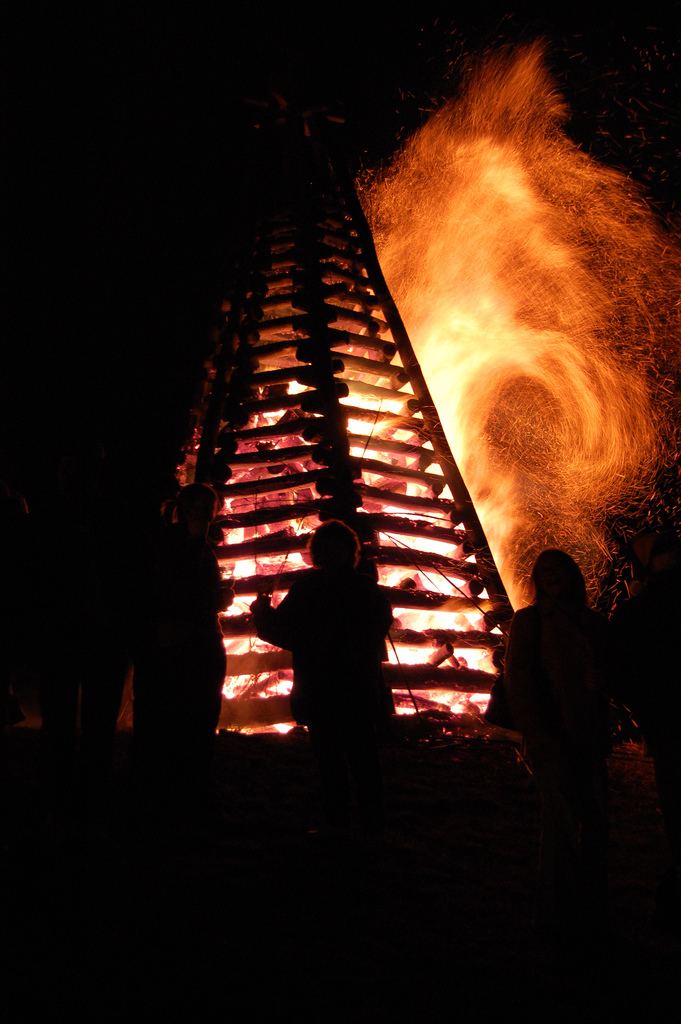 | ||
Bonfire Night is a name given to various annual celebrations characterised by bonfires and fireworks. The event celebrates different traditions on different dates, depending on the country. Some of the most popular instances include Guy Fawkes Night (5 November) in the United Kingdom, which is also celebrated in some Commonwealth countries; Northern Ireland's Eleventh Night (11 July), and 5 November in Newfoundland and Labrador. Often known as St John's Eve (23 June), a similar bonfire tradition survives in parts of Ireland as well as Scandinavia where it is known as Walpurgis Night (30th April). St John's Eve is also a very important celebration in Galicia and Northern Portugal. Several other cultures also include night-time celebrations involving bonfires and/or fireworks.
Contents
Bonfire Night is also celebrated in Northern Ireland on 9 August in republican communities to mark the anniversary of the introduction of internment in 1971 (Operation Demetrius).
Significances
In Great Britain, Bonfire Night is associated with the tradition of celebrating the failure of Guy Fawkes' actions on 5 November 1605. The British festival is, therefore, on 5 November, although some commercially driven events are held at a weekend near to the correct date, to maximise attendance. Bonfire night's sectarian significance has generally been lost: it is now usually just a night of revelry with a bonfire and fireworks, although an effigy of Guy Fawkes is burned on the fire. Celebrations are held throughout Great Britain; in some non-Catholic communities in Northern Ireland; and in some other parts of the Commonwealth. In the Canadian province of Newfoundland and Labrador, 5 November is commemorated with bonfires and firework displays, and it is officially celebrated in South Africa.
In Northern Ireland, the term "Bonfire Night" can refer to the Eleventh Night celebrations of 11 July. Like 5 November, this Bonfire Night also has its roots in the sectarian struggle between Protestants and Catholics. Unlike 5 November the sectarian significance of 11 July is still strong. It celebrates the Battle of the Boyne of 1690, in which the Protestant William of Orange defeated the Catholic James II.
In rural parts of the Republic of Ireland "Bonfire Night" refers to 23 June, St John's Eve night. It has its origins in a religious celebration and originally featured prayers for bountiful crops. The night is linked to the summer solstice or Midsummer's Eve. Originally fires were lit to honour the goddess Áine as part of a Celtic celebration; the Catholic Church took over the pagan festival and linked it to the birth of St John.
Social impact
Bonfire celebrations can pose a risk to public safety due to the possibility of fires, injuries, or fights. For example, in London, calls to firefighting services are nearly tripled on Bonfire Night. In Belfast, the July 2003 Eleventh Night resulted in £10,000 worth of damage to a park. The use of fireworks may lead to dangerous pyrotechnic incidents. In parts of the Caribbean, laws banning fireworks and explosives have muted the occasion, and safety concerns in New Zealand have resulted in restrictions on fireworks use, although public firework displays remain popular there.
The tradition of Bonfire Night has been criticised for its environmental impact. A 1994 study conducted in Oxford, England, found a four-fold increase in dioxin and furan concentration in the air after a Bonfire Night celebration. In 2005 a Bonfire Night in Newfoundland prompted the provincial Minister of Environment and Conservation to remind the general public of their responsibilities for safety and the environment.
Food
There are many food items that are associated with Bonfire Night. Toffee apples, treacle toffee, black peas and parkin, and even the jacket potato, are traditionally eaten around Bonfire Night in parts of England.
